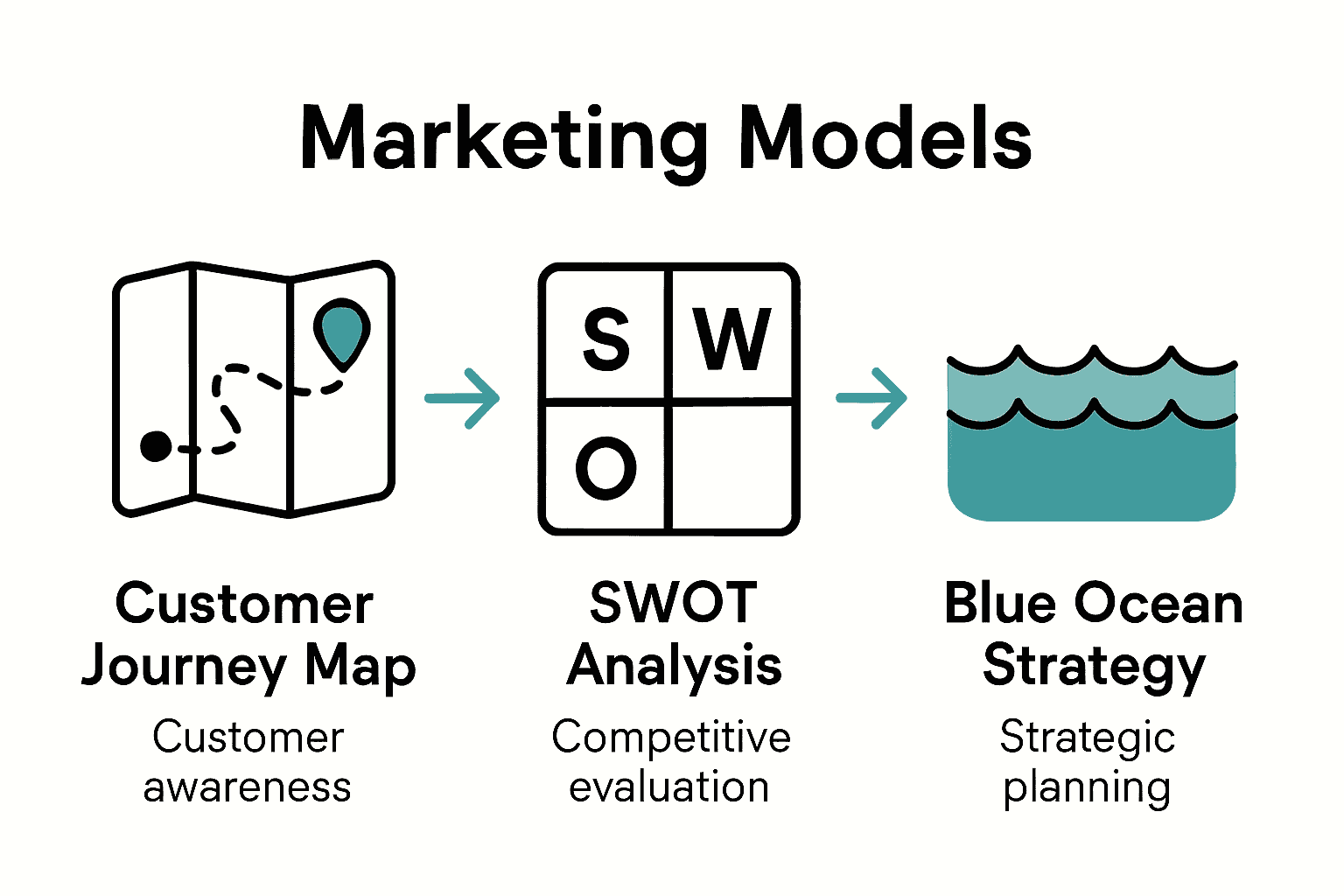Branding Strategies: Building Impactful Small Businesses

Comprehensive guide to marketing systems for entrepreneurs—core concepts, system types, practical implementation, common mistakes, and real-world benefits.

Did you know that only about 50 percent of small businesses survive past five years? The difference often comes down to having a reliable marketing system that does more than react to guesswork. Entrepreneurs who understand how to connect their brand’s value with the right people can build loyal audiences and drive steady sales. This guide explains the strategic building blocks behind marketing systems so you can move past trial and error toward lasting business growth.
Marketing systems aren’t just complicated corporate flowcharts—they’re the strategic heartbeat of how entrepreneurs turn strangers into loyal customers. At its core, a marketing system is a repeatable process that connects your business’s unique value to the right audience, transforming random interactions into predictable revenue streams.
Think of a marketing system like an ecosystem. Just as natural ecosystems have interconnected elements working together, your marketing system links several critical components: brand positioning, audience targeting, lead generation, and conversion strategies. Each element doesn’t work in isolation but creates a dynamic, self-sustaining environment that consistently attracts and converts ideal clients.
For entrepreneurs, a well-designed marketing system means freedom. No more throwing spaghetti at the marketing wall and hoping something sticks. Instead, you create a strategic framework that works while you focus on delivering exceptional value to your clients. It transforms marketing from a chaotic, stressful activity into a predictable, scalable growth engine.
Entrepreneurs aren’t stuck with a one-size-fits-all marketing approach. Marketing models are like different strategic tools in your business toolkit, each designed to solve specific challenges and help you navigate your unique growth journey. Some models focus on understanding customer behavior, while others help you explore untapped market opportunities or analyze competitive landscapes.
Let’s break down some powerful marketing models entrepreneurs can leverage:
Here’s a comparison of popular marketing models for entrepreneurs:
| Model | Main Purpose | Key Benefit |
|---|---|---|
| Customer Journey Map | Tracks client path to purchase | Uncovers critical touchpoints |
| Value Proposition Canvas | Aligns offerings with customer needs | Clarifies unique selling points |
| Blue Ocean Strategy | Finds uncontested market spaces | Reduces competition |
| SWOT Analysis | Assesses business and market factors | Highlights strengths & weaknesses |
| Ansoff’s Matrix | Guides market and product expansion | Identifies growth opportunities |
Each model offers a different lens for understanding your business ecosystem.
 The Customer Journey Map reveals emotional and practical touchpoints in your customer’s decision-making process. The Blue Ocean Strategy encourages you to create unique value that makes competition meaningless. Meanwhile, SWOT Analysis provides a brutally honest snapshot of your current business positioning.
The Customer Journey Map reveals emotional and practical touchpoints in your customer’s decision-making process. The Blue Ocean Strategy encourages you to create unique value that makes competition meaningless. Meanwhile, SWOT Analysis provides a brutally honest snapshot of your current business positioning.
The key isn’t to adopt every model but to choose the ones that align with your specific business goals. Think of these models as strategic compasses—they don’t replace your entrepreneurial intuition but provide structured insights to help you navigate complex market dynamics with greater confidence and clarity.

A marketing system is more than a collection of random tactics—it’s a precisely engineered machine with interconnected components working in synchronized harmony. Think of it like a complex musical ensemble where each instrument plays a critical role in creating a beautiful, unified performance. Your marketing system’s core components are designed to transform cold leads into passionate brand advocates through strategic, intentional interactions.
The primary components of an effective marketing system include:
Under the hood, these components operate like an advanced Marketing Decision Support System (MKDSS). This integrated approach combines information technology, marketing data, and analytical modeling tools to help entrepreneurs simulate different scenarios, optimize their marketing mix, and make data-driven decisions. By understanding how each component connects and influences the others, you transform marketing from a hit-or-miss activity into a predictable, scalable growth strategy.
The magic happens when these components work together seamlessly. Your data informs your audience segmentation, your value proposition guides channel selection, and your conversion mechanisms are continuously refined based on real-world performance. It’s a living, breathing system that adapts and evolves with your business, ensuring you’re always one step ahead in connecting with your ideal customers.
The Aligned Impact Model™ represents more than just another marketing framework—it’s a strategic blueprint designed to transform how entrepreneurs approach business growth. Unlike traditional marketing approaches that treat strategy as a static document, this model creates a dynamic, living system that adapts and evolves with your business’s unique journey. It’s about creating intentional alignment between your brand’s core purpose, market positioning, and growth mechanisms.
The model breaks down into several key stages that work together to create a holistic marketing ecosystem:
What sets the Aligned Impact Model™ apart is its focus on intrinsic alignment. It’s not just about generating leads or increasing revenue—it’s about creating a marketing system that amplifies your business’s core mission. This approach helps entrepreneurs avoid mission drift, ensuring that every marketing effort authentically represents your brand’s deeper purpose. By integrating impact directly into your business model, you create a more meaningful connection with your audience.
Think of the model as a living, breathing roadmap. It provides structure without rigidity, offering entrepreneurs a flexible framework that grows and adapts with their business. The goal isn’t to follow a prescriptive set of steps, but to create a responsive system that turns your unique vision into a sustainable, impactful business strategy.
Building a marketing system isn’t just about having a great strategy—it’s about avoiding the landmines that can derail your entrepreneurial journey. Most marketing failures don’t happen because of a bad idea, but because of critical blind spots that slowly erode your business’s potential. Think of these pitfalls like silent termites, quietly undermining the foundation of your marketing efforts before you even realize something’s wrong.
The most dangerous traps entrepreneurs often fall into include:
Strategic adaptation is the key to avoiding these common mistakes. Most entrepreneurs get stuck in what I call the “hope marketing” cycle—randomly trying tactics and hoping something magically works. Instead, you need a systematic approach that treats marketing like a science. This means developing a repeatable process for testing, measuring, and refining your strategies. You’re not just throwing spaghetti at the wall; you’re carefully experimenting, tracking results, and making data-driven decisions.
The ultimate protection against these pitfalls is building a flexible, responsive marketing system. Treat your marketing like a living organism that needs constant nurturing, observation, and strategic adjustment. Your goal isn’t perfection—it’s continuous improvement. By staying curious, remaining adaptable, and always being willing to learn from both successes and failures, you transform potential pitfalls into opportunities for growth and innovation.
If you are tired of the chaos that comes from sporadic marketing or chasing trends with no real results, you are not alone. Many entrepreneurs struggle to bridge the gap between understanding concepts like audience targeting, conversion strategies, and building real, sustainable growth. The article revealed the struggle with inconsistent messaging and the high cost of one-size-fits-all approaches. Now is the moment to transform your insight into action with a process built for clarity and confidence.

Let Reasonate Studio help you build a marketing system that works for you, not against you. Leverage The Aligned Impact Model™ to shift from random tactics to a fully aligned growth engine. Visit Reasonate Studio for a free discovery call and see how your journey toward streamlined, intentional marketing can begin today. Take the next step toward building a brand that resonates and scales with purpose.
A marketing system for entrepreneurs is a repeatable process that connects a business’s unique value to the right audience, turning random interactions into predictable revenue streams.
The core components include data collection, audience segmentation, value proposition development, channel strategy, and conversion mechanisms, all working together to guide potential customers through the buying process.
The Aligned Impact Model™ creates intentional alignment between your brand’s core purpose and growth strategies, helping you build a responsive marketing system that adapts as your business evolves.
Common pitfalls include inconsistent messaging, focusing on vanity metrics, using a one-size-fits-all approach, not tracking your efforts, and treating marketing as an afterthought. It’s essential to adopt a systematic and flexible approach for effective marketing.